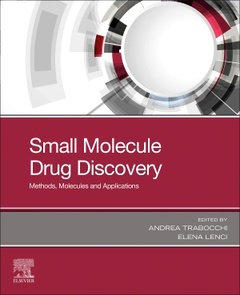Description
Small Molecule Drug Discovery
Methods, Molecules and Applications
Coordinators: Trabocchi Andrea, Lenci Elena
Language: English
Subject for Small Molecule Drug Discovery:
356 p. · 19x23.3 cm · Paperback
Description
/li>Contents
/li>Biography
/li>Comment
/li>
Small Molecule Drug Discovery: Methods, Molecules and Applications presents the methods used to identify bioactive small molecules, synthetic strategies and techniques to produce novel chemical entities and small molecule libraries, chemoinformatics to characterize and enumerate chemical libraries, and screening methods, including biophysical techniques, virtual screening and phenotypic screening. The second part of the book gives an overview of privileged cyclic small molecules and major classes of natural product-derived small molecules, including carbohydrate-derived compounds, peptides and peptidomimetics, and alkaloid-inspired compounds. The last section comprises an exciting collection of selected case studies on drug discovery enabled by small molecules in the fields of cancer research, CNS diseases and infectious diseases.
The discovery of novel molecular entities capable of specific interactions represents a significant challenge in early drug discovery. Small molecules are low molecular weight organic compounds that include natural products and metabolites, as well as drugs and other xenobiotics. When the biological target is well defined and understood, the rational design of small molecule ligands is possible. Alternatively, small molecule libraries are being used for unbiased assays for complex diseases where a target is unknown or multiple factors contribute to a disease pathology.
1. Synthetic Approaches Toward Small Molecule Libraries 2. Chemical Reactions for Building Small Molecules 3. Chemoinformatics to Assess Chemical Diversity and Complexity of Small Molecules 4. Virtual Screening of Small Molecule Libraries 5. Biophysical Methods for Screening and Characterization of Small Molecules 6. Small Molecule Peptidomimetics: Principles, Molecules, and Applications 7. sp2-Iminosugars as Chemical Mimics for Glycodrug Design 8. Synthesis and Biological Properties of Spiroacetal-containing Small Molecules 9. Centrocountins: Synthesis and Chemical Biology of Nature Inspired Indoloquinolizines 10. PPIs as Therapeutic Targets for Anti-cancer Drug Discovery: The Case Study of MDM2 and BET Bromodomain Inhibitors 11. Discovery of Small Molecules for the Treatment of Alzheimer's Disease
Elena Lenci received the Doctor Europaeus PhD in Chemical Science in 2017 from the University of Florence, after spending a research period at the University of Oxford, UK. She is currently a postdoctoral researcher at the Department of Chemistry, University of Florence, developing novel amino acid- and sugar-derived scaffolds for medicinal chemistry projects. In 2015 she was awarded the Reaxys - Italian Chemical Society Young Researcher Award, and in 2017 she received the International Award for Young Chemists NATCHEMDRUGS. Besides her work in organic chemistry, she has served as a board-member in the Young Group of the Italian Chemical Society since 2016, and as a board member in the Chemical Cultural Diffusion Group since 2019.
- Outlines modern concepts and synthetic strategies underlying the building of small molecules and their chemical libraries useful for drug discovery
- Provides modern biophysical methods to screening small molecule libraries, including high-throughput screening, small molecule microarrays, phenotypic screening and chemical genetics
- Presents the most advanced chemoinformatics tools to characterize the structural features of small molecule libraries in terms of chemical diversity and complexity, also including the application of virtual screening approaches
- Gives an overview of structural features and classification of natural product-derived small molecules, including carbohydrate derivatives, peptides and peptidomimetics, and alkaloid-inspired small molecules




